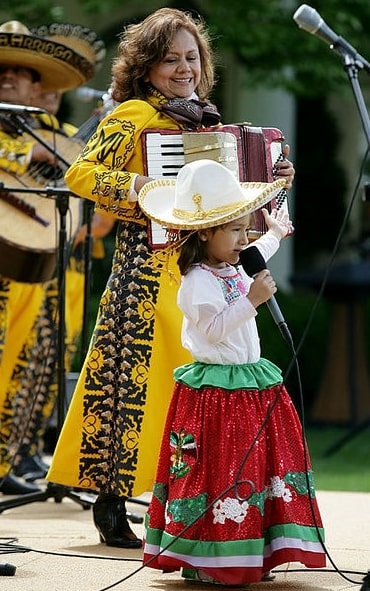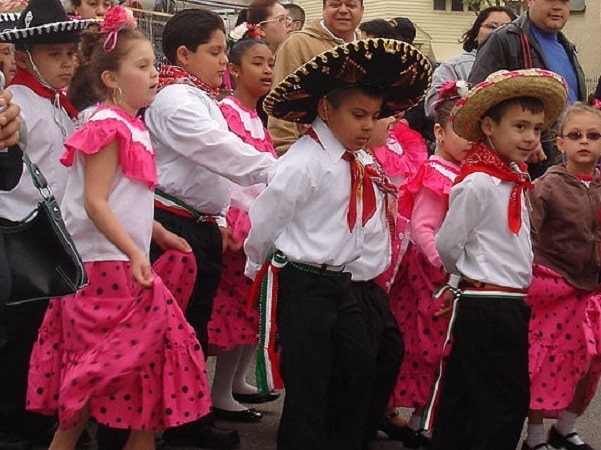Introduction: In this article – to help celebrate Cinco de Mayo this Sunday – Gena Philibert-Ortega gives tips and helpful links for exploring your Mexican family history. Gena is a genealogist and author of the book “From the Family Kitchen.”
Cinco de Mayo, or May 5th, is not Mexican Independence Day. This special day actually commemorates an 1862 battle during the Franco-Mexican War: during the Battle of Pueblo, the underdog Mexican army was victorious over the larger French army. The day in Mexico is one of patriotic pride.
In America, Cinco de Mayo has become a Hispanic cultural holiday, with less emphasis on the true roots. In fact, this holiday seems to be celebrated more in America than in many parts of Mexico. Cinco de Mayo in America is now a commercialized holiday with emphasis on Mexican food and drink.

However, perhaps Cinco de May has got you wondering about your Mexican family history. Ready to start researching your Mexican roots? The following are five tips to get you started.
Tip #1: Start with Questions
Always start your family history research with questions. What do you already know? Where did your family live? What is your research question? What records exist for that time and place?
Make sure to start an online family tree or fill out a family tree form. You should also keep a research log of what you find. You’ll want to record what you know and what you learn along the way.
Tip #2: Seek Out Home Sources
Always consider home sources when starting family history research. Don’t overlook inherited items that appear to have little genealogical value. For example, I was researching a Mexican ancestor who immigrated to Texas from Chihuahua in the early 1900s. Very little was known about him. His Texas middle school report card in the possession of the family didn’t seem relevant – but it provided his parents’ names. The mother’s signature on the card added more to the story. Previously it was believed that the man had immigrated with a sibling and not his parents, but his mother’s signature on the report card showed that she did indeed come to the United States. That report card signature led to additional records.
Consult home sources and ask questions of family members. Any family document – no matter how insignificant it may seem – with careful analysis may hold a valuable clue.
Tip #3: Start with the United States
If your Mexican family immigrated to the United States from Mexico you will want to start with records about the immigrants created here in the United States, before you research back in time using Mexican records.
Start with records created in the United States. Records to exhaust include border crossings, naturalizations, censuses, and vital records. Those records can help you identify where to research in Mexico.
Newspapers are integral to genealogical research. Don’t forget to identify Spanish-language newspapers printed in the United States and popular where your ancestors lived. These newspapers would have reported on Mexico as well as local Mexican American communities. This will provide some historical context for your ancestor’s time as well as a possible mention.
GenealogyBank has a collection of Spanish-language and bilingual newspapers dating back to the early 1800s. You can search them here: Hispanic American Newspaper Archives.
Tip #4: Know Your History and Records
History
Once you’re ready to start researching Mexican records and repositories, knowing the history of Mexico can help.
- 1519: Spaniard Hernán Cortés defeats the Aztecs, which leads to much of Mexico being ruled by Spain and referred to as “New Spain.” New Spain covered Central America and parts of the present-day United States including Arizona, California, Colorado, Nevada, New Mexico, Texas, Utah and Wyoming.
- 1564: After 20 years, The Council of Trent (held in Italy) ends and dictates that Catholic priests must record baptisms, marriages, and deaths for each parishioner. The Pope officially requires the keeping of parish records in 1595.
- 1821: Mexican independence from Spain.
- 1848: The Treaty of Guadalupe de Hidalgo is signed, ending the Mexican-American War, with the United States gaining California, Arizona, Nevada, Utah and parts of Wyoming, Colorado and New Mexico.
- 1859: Mexican civil registration begins.
- 1910-1920: Mexican Revolution.
- 1917: Current constitution of the United Mexican States written.
Maps
As you start your research, make sure that you use historical maps to learn more about where your Mexican ancestors lived. Be aware that there can be confusion over place names and even misspellings on maps published in English. Place names change over time, and in some cases, multiple locations share a common name. Websites with historical maps include the FamilySearch Research Wiki page Mexico Maps and the University of Texas at Austin’s Perry-Castañeda Map Collection.
Records
Mexican records to consider include:
- Census: Censuses were taken by the government and the Catholic Church. A 1689 census of Spaniards in Mexico City is available at the FamilySearch Library. The only available federal census is the 1930 census, available from FamilySearch.
- Church Records: Earliest and best sources for tracing your Mexican Catholic ancestor are church records. The first Mexican diocese was founded in 1527 and church records started after. You can refer to the Mexico Church Records page on the FamilySearch Research Wiki for years that various dioceses started keeping records. Next, consult the FamilySearch Catalog, searching by location for available records before taking the next step and writing to a parish or diocese.
- Civil Registration: Vital record registrations for birth, marriage, and death began in 1859 and should be expected for anyone who lived in Mexico after 1867. For any ancestor born, married, or died after 1867, check civil registration first and then Catholic Church records. The constitution of 1917 called for the separation of church and state, which meant couples had to be married by the state. Though not always followed, some couples got married civilly and then at church.
- Military Records: In Mexico these records can range from service records and pensions, to censuses, enlistments and conscriptions. See the FamilySearch Research Wiki for where to write for military records, what military records are available, and for whom.
Are the above all the available records for your family history? No, and it goes without saying that depending on the time period of your ancestor, records and their availability will differ. The FamilySearch Research Wiki page Mexico Genealogy is a good resource for additional records, as well as the book Finding Your Mexican Ancestors: A Beginner’s Guide by George & Peggy Ryskamp.
Tip #5: Exhaust FamilySearch
You can tell by now that FamilySearch is a valuable resource for researching Mexican ancestors. Make sure to peruse the Historical Records Collection for Mexico for vital records and Catholic Church records.
In the FamilySearch Catalog conduct a search for the places your ancestor lived. Once you do this, go through the subject categories and see what resources might be of use to your research.
One benefit to FamilySearch, aside from available records, is the Wiki. Look for wiki articles that explain Mexican genealogy research, provide more information on a specific record set, or provide language assistance. The Mexico Genealogy page provides getting started tips, information on record types, and links to videos and tutorials on researching Spanish language handwriting. A wiki page titled Mexico Languages will help you learn how to recognize commonly used genealogy words in Spanish.
Get Started!
Start researching today. Start with you, ask your family for what they know, and use information found online before you seek out Mexican repositories.
Explore over 330 years of newspapers and historical records in GenealogyBank. Discover your family story! Start a 7-Day Free Trial
Note on the header image: Cinco de Mayo parade in Saint Paul, Minnesota, 2007. Credit: Rena Dehler; Wikimedia Commons.
Related Articles:
- Celebrate Cinco de Mayo by Tracing Your Hispanic Genealogy
- Three Things You Probably Didn’t Know about Cinco de Mayo
- 3 Facts about Cinco de Mayo
Recipes for Cinco de Mayo:
